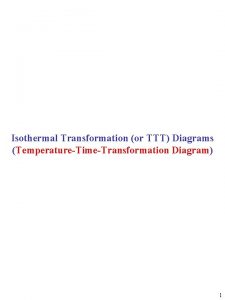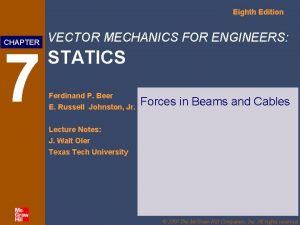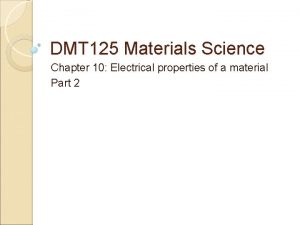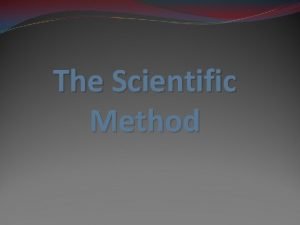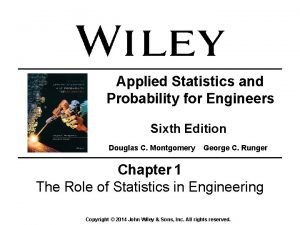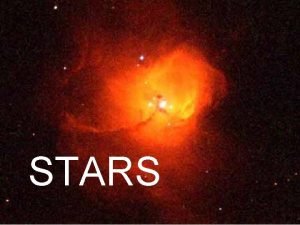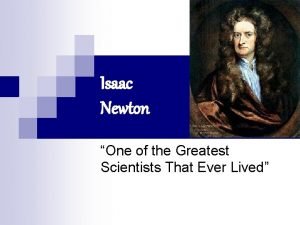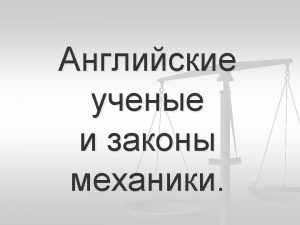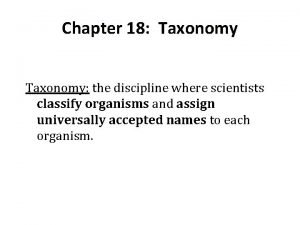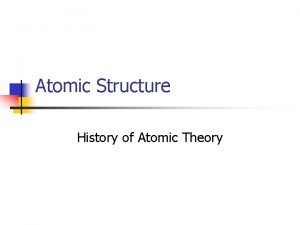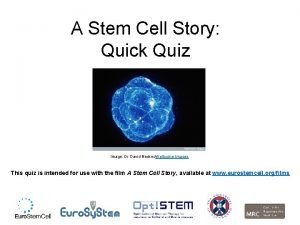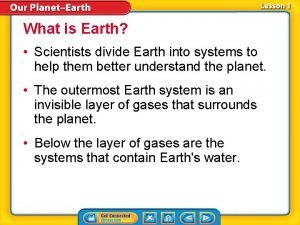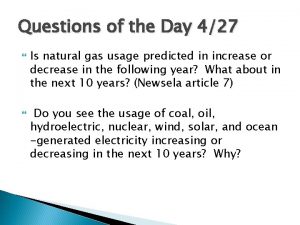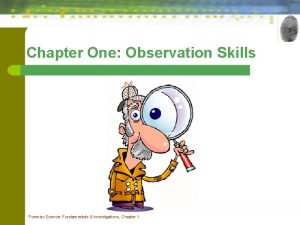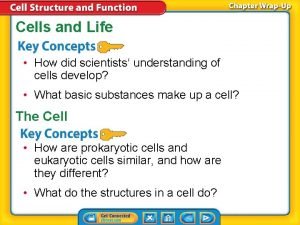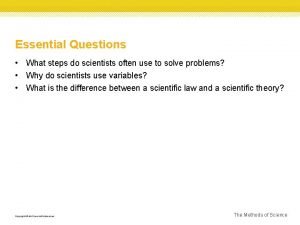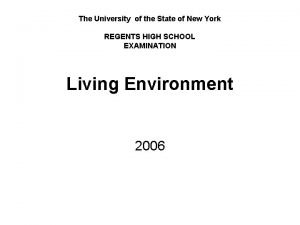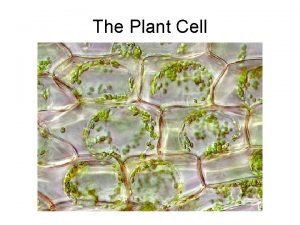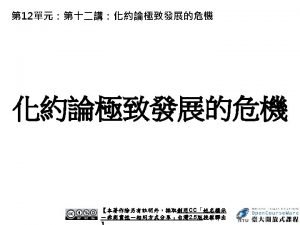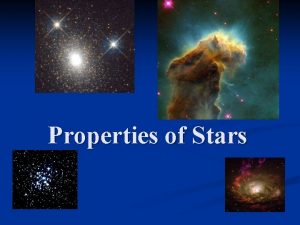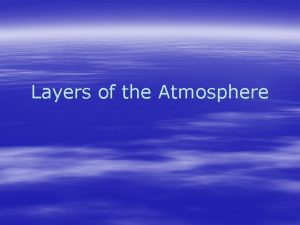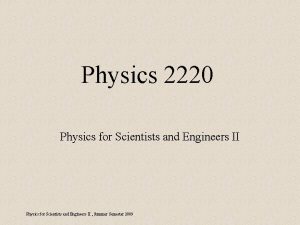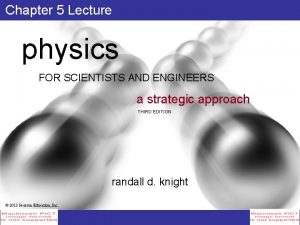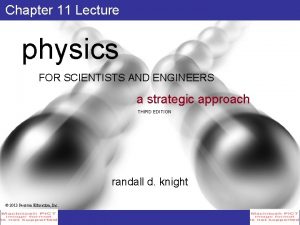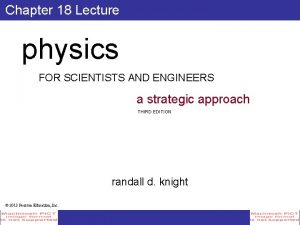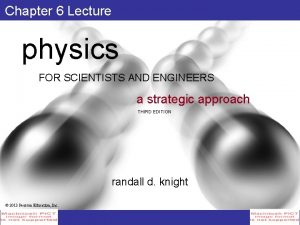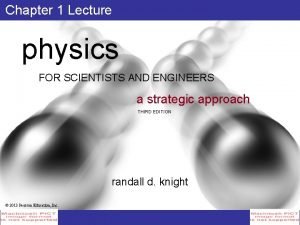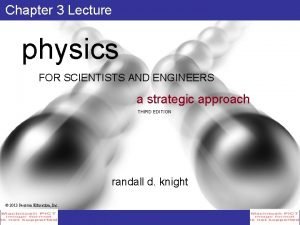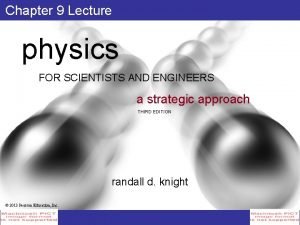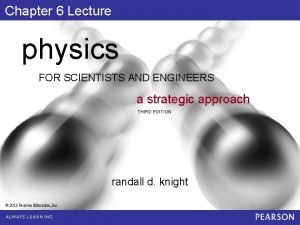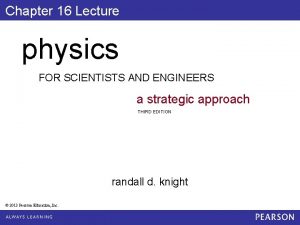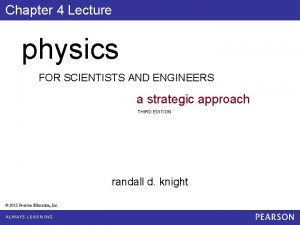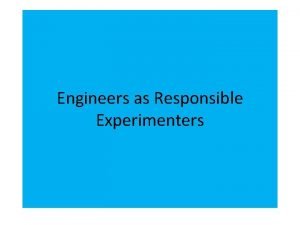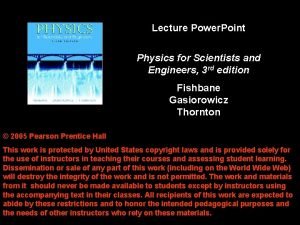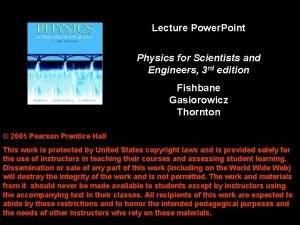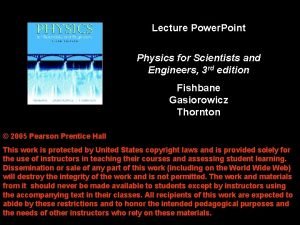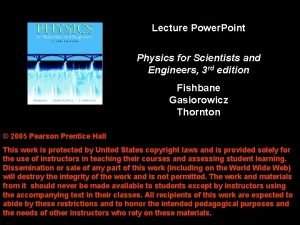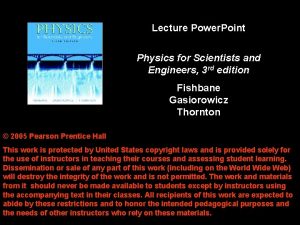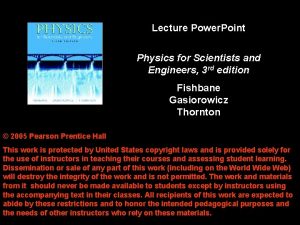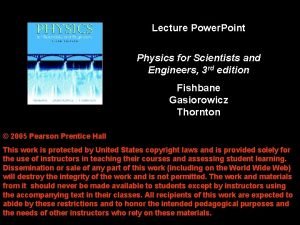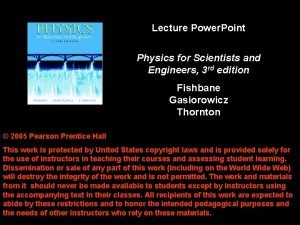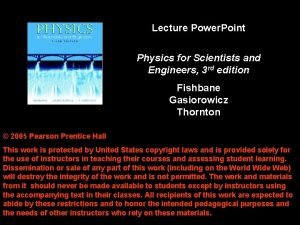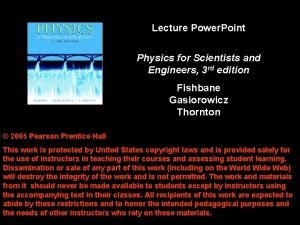Chapter 10 Lecture physics FOR SCIENTISTS AND ENGINEERS

























































































































- Slides: 121

Chapter 10 Lecture physics FOR SCIENTISTS AND ENGINEERS a strategic approach THIRD EDITION randall d. knight © 2013 Pearson Education, Inc.

Chapter 10 Energy Chapter Goal: To introduce the concept of energy and the basic energy model. © 2013 Pearson Education, Inc. Slide 10 -2

Chapter 10 Preview © 2013 Pearson Education, Inc. Slide 10 -3

Chapter 10 Preview © 2013 Pearson Education, Inc. Slide 10 -4

Chapter 10 Preview © 2013 Pearson Education, Inc. Slide 10 -5

Chapter 10 Preview © 2013 Pearson Education, Inc. Slide 10 -6

Chapter 10 Preview © 2013 Pearson Education, Inc. Slide 10 -7

Chapter 10 Reading Quiz © 2013 Pearson Education, Inc. Slide 10 -8

Reading Question 10. 1 Kinetic energy is A. Mass times velocity. B. ½ mass times speed-squared. C. The area under the force curve in a forceversus-time graph. D. Velocity per unit mass. © 2013 Pearson Education, Inc. Slide 10 -9

Reading Question 10. 1 Kinetic energy is A. Mass times velocity. B. ½ Mass times speed-squared. C. The area under the force curve in a forceversus-time graph. D. Velocity per unit mass. © 2013 Pearson Education, Inc. Slide 10 -10

Reading Question 10. 2 A method for keeping track of transformations between kinetic energy and gravitational potential energy, introduced in this chapter, is A. Credit-debit tables. B. C. D. E. Kinetic energy-versus-time graphs. Energy bar charts. Energy conservation pools. Energy spreadsheets. © 2013 Pearson Education, Inc. Slide 10 -11

Reading Question 10. 2 A method for keeping track of transformations between kinetic energy and gravitational potential energy, introduced in this chapter, is A. Credit-debit tables. B. C. D. E. Kinetic energy-versus-time graphs. Energy bar charts. Energy conservation pools. Energy spreadsheets. © 2013 Pearson Education, Inc. Slide 10 -12

Reading Question 10. 3 Mechanical energy is A. The energy due to internal moving parts. B. The energy of motion. C. The energy of position. D. The sum of kinetic energy plus potential energy. E. The sum of kinetic, potential, thermal, and elastic energy. © 2013 Pearson Education, Inc. Slide 10 -13

Reading Question 10. 3 Mechanical energy is A. The energy due to internal moving parts. B. The energy of motion. C. The energy of position. D. The sum of kinetic energy plus potential energy. E. The sum of kinetic, potential, thermal, and elastic energy. © 2013 Pearson Education, Inc. Slide 10 -14

Reading Question 10. 4 Hooke’s law describes the force of A. Gravity. B. A spring. C. Collisions. D. Tension. E. None of the above. © 2013 Pearson Education, Inc. Slide 10 -15

Reading Question 10. 4 Hooke’s law describes the force of A. Gravity. B. A spring. C. Collisions. D. Tension. E. None of the above. © 2013 Pearson Education, Inc. Slide 10 -16

Reading Question 10. 5 A perfectly elastic collision is a collision A. Between two springs. B. That conserves thermal energy. C. That conserves kinetic energy. D. That conserves potential energy. E. That conserves mechanical energy. © 2013 Pearson Education, Inc. Slide 10 -17

Reading Question 10. 5 A perfectly elastic collision is a collision A. Between two springs. B. That conserves thermal energy. C. That conserves kinetic energy. D. That conserves potential energy. E. That conserves mechanical energy. © 2013 Pearson Education, Inc. Slide 10 -18

Chapter 10 Content, Examples, and Quick. Check Questions © 2013 Pearson Education, Inc. Slide 10 -19

Kinetic Energy K § Kinetic energy is the energy of motion. § All moving objects have kinetic energy. § The more massive an object or the faster it moves, the larger its kinetic energy. © 2013 Pearson Education, Inc. Slide 10 -20

Potential Energy U § Potential energy is stored energy associated with an object’s position. § The roller coaster’s gravitational potential energy depends on its height above the ground. © 2013 Pearson Education, Inc. Slide 10 -21

Thermal Energy Eth § Thermal energy is the sum of the microscopic kinetic and potential energies of all the atoms and bonds that make up the object. § An object has more thermal energy when hot than when cold. © 2013 Pearson Education, Inc. Slide 10 -22

The Basic Energy Model § Within a system, energy can be transformed from one type to another. § The total energy of the system is not changed by these transformations. § This is the law of conservation of energy. § Energy can also be transferred from one system to another. § The mechanical transfer of energy to a system via forces is called work. © 2013 Pearson Education, Inc. Slide 10 -23

Kinetic Energy and Gravitational Potential Energy § The figure shows a before-and-after representation of an object in free fall. § One of the kinematics equations from Chapter 2, with ay = g, is: § Rearranging: § Multiplying both sides by ½m: © 2013 Pearson Education, Inc. Slide 10 -24

Kinetic Energy and Gravitational Potential Energy Define kinetic energy as an energy of motion: Define gravitational potential energy as an energy of position: The sum K + Ug is not changed when an object is in free fall. Its initial and final values are equal: © 2013 Pearson Education, Inc. Slide 10 -25

Kinetic Energy and Gravitational Potential Energy © 2013 Pearson Education, Inc. Slide 10 -26

Quick. Check 10. 1 A child is on a playground swing, motionless at the highest point of his arc. What energy transformation takes place as he swings back down to the lowest point of his motion? A. K Ug B. Ug K C. Eth K D. Ug Eth E. K Eth © 2013 Pearson Education, Inc. Slide 10 -27

Quick. Check 10. 1 A child is on a playground swing, motionless at the highest point of his arc. What energy transformation takes place as he swings back down to the lowest point of his motion? A. K Ug B. Ug K C. Eth K D. Ug Eth E. K Eth © 2013 Pearson Education, Inc. Slide 10 -27

Quick. Check 10. 2 A skier is gliding down a gentle slope at a constant speed. What energy transformation is taking place? A. K Ug B. Ug K C. Eth K D. Ug Eth E. K Eth © 2013 Pearson Education, Inc. Slide 10 -29

Quick. Check 10. 2 A skier is gliding down a gentle slope at a constant speed. What energy transformation is taking place? A. K Ug B. Ug K C. Eth K D. Ug Eth E. K Eth © 2013 Pearson Education, Inc. Slide 10 -30

Example 10. 1 Launching a Pebble © 2013 Pearson Education, Inc. Slide 10 -31

Example 10. 1 Launching a Pebble © 2013 Pearson Education, Inc. Slide 10 -32

Example 10. 1 Launching a Pebble © 2013 Pearson Education, Inc. Slide 10 -33

Energy Bar Charts § A pebble is tossed up into the air. § The simple bar charts below show the sum of K + Ug remains constant as the pebble rises and then falls. © 2013 Pearson Education, Inc. Slide 10 -34

Energy Bar Charts § The figure below shows how to make an energy bar chart suitable for problem solving. § The chart is a graphical representation of the energy equation Kf + Ugf = Ki + Ugi. © 2013 Pearson Education, Inc. Slide 10 -35

Quick. Check 10. 3 Ball A has half the mass and eight times the kinetic energy of ball B. What is the speed ratio v. A/v. B? A. 16 B. 4 C. 2 D. 1/4 E. 1/16 © 2013 Pearson Education, Inc. Slide 10 -36

Quick. Check 10. 3 Ball A has half the mass and eight times the kinetic energy of ball B. What is the speed ratio v. A/v. B? A. 16 B. 4 C. 2 D. 1/4 E. 1/16 © 2013 Pearson Education, Inc. Slide 10 -37

Quick. Check 10. 4 Rank in order, from largest to smallest, the gravitational potential energies of the balls. A. 1 > 2 = 4 > 3 B. 1 > 2 > 3 > 4 C. 3 > 2 > 4 > 1 D. 3 > 2 = 4 > 1 © 2013 Pearson Education, Inc. Slide 10 -38

Quick. Check 10. 4 Rank in order, from largest to smallest, the gravitational potential energies of the balls. A. 1 > 2 = 4 > 3 B. 1 > 2 > 3 > 4 C. 3 > 2 > 4 > 1 D. 3 > 2 = 4 > 1 © 2013 Pearson Education, Inc. Slide 10 -39

The Zero of Potential Energy § Amber and Bill use coordinate systems with different origins to determine the potential energy of a rock. § No matter where the rock is, Amber’s value of Ug will be equal to Bill’s value plus 9. 8 J. § If the rock moves, both will calculate exactly the same value for Ug. § In problems, only Ug has physical significance, not the value of Ug itself. © 2013 Pearson Education, Inc. Slide 10 -40

Example 10. 2 The Speed of a Falling Rock © 2013 Pearson Education, Inc. Slide 10 -41

Example 10. 2 The Speed of a Falling Rock © 2013 Pearson Education, Inc. Slide 10 -42

Example 10. 2 The Speed of a Falling Rock © 2013 Pearson Education, Inc. Slide 10 -43

Example 10. 2 The Speed of a Falling Rock ASSESS The figure below shows energy bar charts for Amber and Bill. despite their disagreement over the value of Ug, Amber and Bill arrive at the same value for vf and their Kf bars are the same height. You can place the origin of your coordinate system, and thus the “zero of potential energy, ” wherever you choose and be assured of getting the correct answer to a problem. © 2013 Pearson Education, Inc. Slide 10 -44

Gravitational Potential Energy on a Frictionless Surface – Slide 1 of 4 § Figure (a) shows an object of mass m sliding along a frictionless surface. § Figure (b) shows a magnified segment of the surface that, over some small distance, is a straight line. § Define an s-axis parallel to the direction of motion § Newton’s second law along the axis is: © 2013 Pearson Education, Inc. Slide 10 -45

Gravitational Potential Energy on a Frictionless Surface – Slide 2 of 4 § Using the chain rule, we can write Newton’s second law as: § It is clear from the diagram that the net force along s is: § So Newton’s second law is: © 2013 Pearson Education, Inc. Slide 10 -46

Gravitational Potential Energy on a Frictionless Surface – Slide 3 of 4 § Rearranging, we obtain: § Note from the diagram that sin ds = dy, so: § Integrating this from “before” to “after”: © 2013 Pearson Education, Inc. Slide 10 -47

Gravitational Potential Energy on a Frictionless Surface – Slide 4 of 4 § With K = ½ mv 2 and Ug = mgy, we find that: § The total mechanical energy for a particle moving along any frictionless smooth surface is conserved, regardless of the shape of the surface. © 2013 Pearson Education, Inc. Slide 10 -48

Quick. Check 10. 5 Starting from rest, a marble first rolls down a steeper hill, then down a less steep hill of the same height. For which is it going faster at the bottom? A. Faster at the bottom of the steeper hill. B. Faster at the bottom of the less steep hill. C. Same speed at the bottom of both hills. D. Can’t say without knowing the mass of the marble. © 2013 Pearson Education, Inc. Slide 10 -49

Quick. Check 10. 5 Starting from rest, a marble first rolls down a steeper hill, then down a less steep hill of the same height. For which is it going faster at the bottom? A. Faster at the bottom of the steeper hill. B. Faster at the bottom of the less steep hill. C. Same speed at the bottom of both hills. D. Can’t say without knowing the mass of the marble. © 2013 Pearson Education, Inc. Slide 10 -50

Quick. Check 10. 6 A small child slides down the four frictionless slides A–D. Rank in order, from largest to smallest, her speeds at the bottom. A. v. D > v. A > v. B > v. C B. v. D > v. A = v. B > v. C C. v. C > v. A > v. B > v. D D. v. A = v. B = v. C = v. D © 2013 Pearson Education, Inc. Slide 10 -51

Quick. Check 10. 6 A small child slides down the four frictionless slides A–D. Rank in order, from largest to smallest, her speeds at the bottom. A. v. D > v. A > v. B > v. C B. v. D > v. A = v. B > v. C C. v. C > v. A > v. B > v. D D. v. A = v. B = v. C = v. D © 2013 Pearson Education, Inc. Slide 10 -52

Example 10. 3 The Speed of a Sled © 2013 Pearson Education, Inc. Slide 10 -53

Example 10. 3 The Speed of a Sled © 2013 Pearson Education, Inc. Slide 10 -54

Example 10. 3 The Speed of a Sled © 2013 Pearson Education, Inc. Slide 10 -55

Problem-Solving Strategy: Conservation of Mechanical Energy © 2013 Pearson Education, Inc. Slide 10 -56

Quick. Check 10. 7 Three balls are thrown from a cliff with the same speed but at different angles. Which ball has the greatest speed just before it hits the ground? A. Ball B. C. Ball C. D. All balls have the same speed. © 2013 Pearson Education, Inc. Slide 10 -57

Quick. Check 10. 7 Three balls are thrown from a cliff with the same speed but at different angles. Which ball has the greatest speed just before it hits the ground? A. Ball B. C. Ball C. D. All balls have the same speed. © 2013 Pearson Education, Inc. Slide 10 -58

Quick. Check 10. 8 A hockey puck sliding on smooth ice at 4 m/s comes to a 1 -m-high hill. Will it make it to the top of the hill? A. Yes. B. No. Can’t answer without knowing the mass of the puck. D. Can’t say without knowing the angle of the hill. © 2013 Pearson Education, Inc. Slide 10 -59

Quick. Check 10. 8 A hockey puck sliding on smooth ice at 4 m/s comes to a 1 -m-high hill. Will it make it to the top of the hill? A. Yes. B. No. Can’t answer without knowing the mass of the puck. D. Can’t say without knowing the angle of the hill. © 2013 Pearson Education, Inc. Slide 10 -60

Restoring Forces and Hooke’s Law § The figure shows how a hanging mass stretches a spring of equilibrium length L 0 to a new length L. § The mass hangs in static equilibrium, so the upward spring force balances the downward gravity force. © 2013 Pearson Education, Inc. Slide 10 -61

Restoring Forces and Hooke’s Law § The figure shows measured data for the restoring force of a real spring. § s is the displacement from equilibrium. § The data fall along the straight line: § The proportionality constant k is called the spring constant. § The units of k are N/m. © 2013 Pearson Education, Inc. Slide 10 -62

Hooke’s Law § One end of a spring is attached to a fixed wall. § (Fsp)s is the force produced by the free end of the spring. § s = s – se is the displacement from equilibrium. § The negative sign is the mathematical indication of a restoring force. © 2013 Pearson Education, Inc. Slide 10 -63

Quick. Check 10. 9 The restoring force of three springs is measured as they are stretched. Which spring has the largest spring constant? © 2013 Pearson Education, Inc. Slide 10 -64

Quick. Check 10. 9 The restoring force of three springs is measured as they are stretched. Which spring has the largest spring constant? Steepest slope. Takes lots of force for a small displacement. © 2013 Pearson Education, Inc. Slide 10 -65

Example 10. 5 Pull Until It Slips © 2013 Pearson Education, Inc. Slide 10 -66

Example 10. 5 Pull Until It Slips © 2013 Pearson Education, Inc. Slide 10 -67

Example 10. 5 Pull Until It Slips © 2013 Pearson Education, Inc. Slide 10 -68

Example 10. 5 Pull Until It Slips © 2013 Pearson Education, Inc. Slide 10 -69

Example 10. 5 Pull Until It Slips © 2013 Pearson Education, Inc. Slide 10 -70

Example 10. 5 Pull Until It Slips © 2013 Pearson Education, Inc. Slide 10 -71

Stick-Slip Motion § Earthquakes are an example of stick-slip motion. § Tectonic plates are attempting to slide past each other, but friction causes the edges of the plates to stick together. § Large masses of rock are somewhat elastic and can be “stretched”. § Eventually the elastic force of the deformed rocks exceeds the friction force between the plates. § An earthquake occurs as the plates slip and lurch forward. © 2013 Pearson Education, Inc. The slip can range from a few centimeters in a relatively small earthquake to several meters in a very large earthquake. Slide 10 -72

Elastic Potential Energy § Springs and rubber bands store potential energy that can be transformed into kinetic energy. § The spring force is not constant as an object is pushed or pulled. § The motion of the mass is not constant-acceleration motion, and therefore we cannot use our old kinematics equations. § One way to analyze motion when spring force is involved is to look at energy before and after some motion. © 2013 Pearson Education, Inc. Slide 10 -73

Elastic Potential Energy § The figure shows a beforeand-after situation in which a spring launches a ball. § Integrating the net force from the spring, as given by Hooke’s Law, shows that: § Here K = ½ mv 2 is the kinetic energy. § We define a new quantity: © 2013 Pearson Education, Inc. Slide 10 -74

Elastic Potential Energy § An object moving without friction on an ideal spring obeys: where § Because s is squared, Us is positive for a spring that is either stretched or compressed. § In the figure, Us has a positive value both before and after the motion. © 2013 Pearson Education, Inc. Slide 10 -75

Quick. Check 10. 10 A spring-loaded gun shoots a plastic ball with a launch speed of 2. 0 m/s. If the spring is compressed twice as far, the ball’s launch speed will be A. B. C. D. E. 1. 0 m/s. 2. 8 m/s 4. 0 m/s. 16. 0 m/s. © 2013 Pearson Education, Inc. Slide 10 -76

Quick. Check 10. 10 A spring-loaded gun shoots a plastic ball with a launch speed of 2. 0 m/s. If the spring is compressed twice as far, the ball’s launch speed will be A. B. C. D. E. 1. 0 m/s. 2. 8 m/s 4. 0 m/s. 16. 0 m/s. © 2013 Pearson Education, Inc. Conservation of energy: Double x double v Slide 10 -77

Quick. Check 10. 11 A spring-loaded gun shoots a plastic ball with a launch speed of 2. 0 m/s. If the spring is replaced with a new spring having twice the spring constant (but still compressed the same distance), the ball’s launch speed will be A. B. C. D. E. 1. 0 m/s. 2. 8 m/s. 4. 0 m/s. 16. 0 m/s. © 2013 Pearson Education, Inc. Slide 10 -78

Quick. Check 10. 11 A spring-loaded gun shoots a plastic ball with a launch speed of 2. 0 m/s. If the spring is replaced with a new spring having twice the spring constant (but still compressed the same distance), the ball’s launch speed will be A. B. C. D. E. 1. 0 m/s. 2. 8 m/s. 4. 0 m/s. 16. 0 m/s. © 2013 Pearson Education, Inc. Conservation of energy: Double k increase v by square root of 2 Slide 10 -79

Example 10. 6 A Spring-Launched Plastic Ball © 2013 Pearson Education, Inc. Slide 10 -80

Example 10. 6 A Spring-Launched Plastic Ball © 2013 Pearson Education, Inc. Slide 10 -81

Example 10. 6 A Spring-Launched Plastic Ball © 2013 Pearson Education, Inc. Slide 10 -82

Example 10. 6 A Spring-Launched Plastic Ball © 2013 Pearson Education, Inc. Slide 10 -83

Example 10. 6 A Spring-Launched Plastic Ball © 2013 Pearson Education, Inc. Slide 10 -84

Energy Diagrams § Potential energy is a function of position. § Functions of position are easy to represent as graphs. § A graph showing a system’s potential energy and total energy as a function of position is called an energy diagram. § Shown is the energy diagram of a particle in free fall. § Gravitational potential energy is a straight line with slope mg and zero y-intercept. § Total energy is a horizontal line, since mechanical energy is conserved. © 2013 Pearson Education, Inc. Slide 10 -85

A Four-Frame Movie of a Particle in Free Fall © 2013 Pearson Education, Inc. Slide 10 -86

Energy Diagrams § Shown is the energy diagram of a mass on a horizontal spring. § The potential energy (PE) is the parabola: Us = ½k(x – xe)2 § The PE curve is determined by the spring constant; you can’t change it. § You can set the total energy (TE) to any height you wish simply by stretching the spring to the proper length at the beginning of the motion. © 2013 Pearson Education, Inc. Slide 10 -87

A Four-Frame Movie of a Mass Oscillating on a Spring © 2013 Pearson Education, Inc. Slide 10 -88

Energy Diagrams § Shown is a more general energy diagram. § The particle is released from rest at position x 1. § Since K at x 1 is zero, the total energy TE = U at that point. § The particle speeds up from x 1 to x 2. § Then it slows down from x 2 to x 3. § The particle reaches maximum speed as it passes x 4. § When the particle reaches x 5, it turns around and reverses the motion. © 2013 Pearson Education, Inc. Slide 10 -89

Equilibrium Positions: Stable § Consider a particle with the total energy E 2 shown in the figure. § The particle can be at rest at x 2, but it cannot move away from x 2: This is static equilibrium. § If you disturb the particle, giving it a total energy slightly larger than E 2, it will oscillate very close to x 2. § An equilibrium for which small disturbances cause small oscillations is called a point of stable equilibrium. © 2013 Pearson Education, Inc. Slide 10 -90

Equilibrium Positions: Unstable § Consider a particle with the total energy E 3 shown in the figure. § The particle can be at rest at x 3, and it does not move away from x 3: This is static equilibrium. § If you disturb the particle, giving it a total energy slightly larger than E 3, it will speed up as it moves away from x 3. § An equilibrium for which small disturbances cause the particle to move away is called a point of unstable equilibrium. © 2013 Pearson Education, Inc. Slide 10 -91

Tactics: Interpreting an Energy Diagram © 2013 Pearson Education, Inc. Slide 10 -92

Example 10. 9 Balancing a Mass on a Spring © 2013 Pearson Education, Inc. Slide 10 -93

Example 10. 9 Balancing a Mass on a Spring © 2013 Pearson Education, Inc. Slide 10 -94

Example 10. 9 Balancing a Mass on a Spring © 2013 Pearson Education, Inc. Slide 10 -95

Example 10. 9 Balancing a Mass on a Spring © 2013 Pearson Education, Inc. Slide 10 -96

Example 10. 9 Balancing a Mass on a Spring © 2013 Pearson Education, Inc. Slide 10 -97

Example 10. 9 Balancing a Mass on a Spring © 2013 Pearson Education, Inc. Slide 10 -98

Quick. Check 10. 12 A particle with the potential energy shown is moving to the right. It has 1. 0 J of kinetic energy at x = 1. 0 m. In the region 1. 0 m < x < 2. 0 m, the particle is A. Speeding up. B. Slowing down. C. Moving at constant speed. D. I have no idea. © 2013 Pearson Education, Inc. Slide 10 -99

Quick. Check 10. 12 A particle with the potential energy shown is moving to the right. It has 1. 0 J of kinetic energy at x = 1. 0 m. In the region 1. 0 m < x < 2. 0 m, the particle is A. Speeding up. B. Slowing down. C. Moving at constant speed. D. I have no idea. © 2013 Pearson Education, Inc. Slide 10 -100

Quick. Check 10. 13 A particle with the potential energy shown is moving to the right. It has 1. 0 J of kinetic energy at x = 1. 0 m. Where is the particle’s turning point? A. 1. 0 m. B. 2. 0 m. C. 5. 0 m. D. 6. 0 m. E. It doesn’t have a turning point. © 2013 Pearson Education, Inc. Slide 10 -101

Quick. Check 10. 13 A particle with the potential energy shown is moving to the right. It has 1. 0 J of kinetic energy at x = 1. 0 m. Where is the particle’s turning point? A. 1. 0 m. B. 2. 0 m. C. 5. 0 m. D. 6. 0 m. E. It doesn’t have a turning point. © 2013 Pearson Education, Inc. Slide 10 -102

Quick. Check 10. 14 A particle with this potential energy could be in stable equilibrium at x = A. 0. 0 m. B. 1. 0 m. C. 2. 0 m. D. Either A or C. Either B or C. © 2013 Pearson Education, Inc. Slide 10 -103

Quick. Check 10. 14 A particle with this potential energy could be in stable equilibrium at x = A. 0. 0 m. B. 1. 0 m. C. 2. 0 m. D. Either A or C. Either B or C. © 2013 Pearson Education, Inc. Slide 10 -104

Molecular Bonds § Shown is the energy diagram for the diatomic molecule HCl (hydrogen chloride). § x is the distance between the hydrogen and the chlorine atoms. § The molecule has a stable equilibrium at an atomic separation of xeq = 0. 13 nm. § When the total energy is E 1, the molecule is oscillating, but stable. § If the molecule’s energy is raised to E 2, we have broken the molecular bond. © 2013 Pearson Education, Inc. Slide 10 -105

Elastic Collisions § During an inelastic collision of two objects, some of the mechanical energy is dissipated inside the objects as thermal energy. § A collision in which mechanical energy is conserved is called a perfectly elastic collision. § Collisions between two very hard objects, such as two billiard balls or two steel balls, come close to being perfectly elastic. © 2013 Pearson Education, Inc. Slide 10 -106

A Perfectly Elastic Collision § Consider a head-on, perfectly elastic collision of a ball of mass m 1 and initial velocity (vix)1, with a ball of mass m 2 initially at rest. § The balls’ velocities after the collision are (vfx)1 and (vfx)2. § Momentum is conserved in all isolated collisions. § In a perfectly elastic collision in which potential energy is not changing, the kinetic energy must also be conserved. © 2013 Pearson Education, Inc. Slide 10 -107

A Perfectly Elastic Collision § Simultaneously solving the conservation of momentum equation and the conservation of kinetic energy equations allows us to find the two unknown final velocities. § The result is: © 2013 Pearson Education, Inc. Slide 10 -108

A Perfectly Elastic Collision: Special Case 1 § Consider a head-on, perfectly elastic collision of a ball of mass m 1 and initial velocity (vix)1, with a ball of mass m 2 initially at rest. § Case 1: m 1 = m 2. § Equations 10. 42 give vf 1 = 0 and vf 2 = vi 1. § The first ball stops and transfers all its momentum to the second ball. © 2013 Pearson Education, Inc. Slide 10 -109

A Perfectly Elastic Collision: Special Case 2 § Consider a head-on, perfectly elastic collision of a ball of mass m 1 and initial velocity (vix)1, with a ball of mass m 2 initially at rest. § Case 2: m 1 >> m 2. § Equations 10. 42 give vf 1 vi 1 and vf 2 2 vi 1. § The big first ball keeps going with about the same speed, and the little second ball flies off with about twice the speed of the first ball. © 2013 Pearson Education, Inc. Slide 10 -110

A Perfectly Elastic Collision: Special Case 3 § Consider a head-on, perfectly elastic collision of a ball of mass m 1 and initial velocity (vix)1, with a ball of mass m 2 initially at rest. § Case 3: m 1 << m 2. § Equations 10. 42 give vf 1 ≈ −vi 1 and vf 2 ≈ 0. § The little first rebounds with about the same speed, and the big second ball hardly moves at all. © 2013 Pearson Education, Inc. Slide 10 -111

Perfectly Elastic Collisions: Using Reference Frames § Equations 10. 42 assume ball 2 is at rest. § What if you need to analyze a head-on collision when both balls are moving before the collision? § You could solve the simultaneous momentum and energy equations, but there is an easier way. © 2013 Pearson Education, Inc. Slide 10 -112

Using Reference Frames: Quick Example A 200 g ball moves to the right at 2. 0 m/s. It has a head-on, perfectly elastic collision with a 100 g ball that is moving toward it at 3. 0 m/s. What are the final velocities of both balls? © 2013 Pearson Education, Inc. Slide 10 -113

Using Reference Frames: Quick Example § Figure (a) shows the situation just before the collision in the lab frame L. § Figure (b) shows the situation just before the collision in the frame M that is moving along with ball 2. © 2013 Pearson Education, Inc. Slide 10 -114

Using Reference Frames: Quick Example § We can use Equations 10. 42 to find the post-collision velocities in the moving frame M: § Transforming back to the lab frame L: © 2013 Pearson Education, Inc. Slide 10 -115

Chapter 10 Summary Slides © 2013 Pearson Education, Inc. Slide 10 -116

General Principles © 2013 Pearson Education, Inc. Slide 10 -117

General Principles © 2013 Pearson Education, Inc. Slide 10 -118

Important Concepts © 2013 Pearson Education, Inc. Slide 10 -119

Important Concepts © 2013 Pearson Education, Inc. Slide 10 -120

Important Concepts © 2013 Pearson Education, Inc. Slide 10 -121
 01:640:244 lecture notes - lecture 15: plat, idah, farad
01:640:244 lecture notes - lecture 15: plat, idah, farad Physics 111 lecture notes
Physics 111 lecture notes Physics 101 lecture
Physics 101 lecture Phy101 lecture 1
Phy101 lecture 1 Physics 101 lecture notes pdf
Physics 101 lecture notes pdf Waves pdf notes
Waves pdf notes Atmospheric physics lecture notes
Atmospheric physics lecture notes Introduction to materials science for engineers chapter 10
Introduction to materials science for engineers chapter 10 Vector mechanics for engineers
Vector mechanics for engineers Introduction to materials science for engineers chapter 10
Introduction to materials science for engineers chapter 10 Sometimes scientists make a mistake or
Sometimes scientists make a mistake or Diagrams tables and graphs are used by scientists mainly to
Diagrams tables and graphs are used by scientists mainly to Why does it happen
Why does it happen University physics with modern physics fifteenth edition
University physics with modern physics fifteenth edition Ib physics ia ideas mechanics
Ib physics ia ideas mechanics Kontinuitetshantering
Kontinuitetshantering Novell typiska drag
Novell typiska drag Nationell inriktning för artificiell intelligens
Nationell inriktning för artificiell intelligens Vad står k.r.å.k.a.n för
Vad står k.r.å.k.a.n för Varför kallas perioden 1918-1939 för mellankrigstiden
Varför kallas perioden 1918-1939 för mellankrigstiden En lathund för arbete med kontinuitetshantering
En lathund för arbete med kontinuitetshantering Särskild löneskatt för pensionskostnader
Särskild löneskatt för pensionskostnader Personlig tidbok för yrkesförare
Personlig tidbok för yrkesförare Sura för anatom
Sura för anatom Vad är densitet
Vad är densitet Datorkunskap för nybörjare
Datorkunskap för nybörjare Boverket ka
Boverket ka Mall debattartikel
Mall debattartikel Magnetsjukhus
Magnetsjukhus Nyckelkompetenser för livslångt lärande
Nyckelkompetenser för livslångt lärande Påbyggnader för flakfordon
Påbyggnader för flakfordon Lufttryck formel
Lufttryck formel Offentlig förvaltning
Offentlig förvaltning Kyssande vind analys
Kyssande vind analys Presentera för publik crossboss
Presentera för publik crossboss Teckenspråk minoritetsspråk argument
Teckenspråk minoritetsspråk argument Plats för toran ark
Plats för toran ark Treserva lathund
Treserva lathund Luftstrupen för medicinare
Luftstrupen för medicinare Bästa kameran för astrofoto
Bästa kameran för astrofoto Centrum för kunskap och säkerhet
Centrum för kunskap och säkerhet Byggprocessen steg för steg
Byggprocessen steg för steg Bra mat för unga idrottare
Bra mat för unga idrottare Verktyg för automatisering av utbetalningar
Verktyg för automatisering av utbetalningar Rutin för avvikelsehantering
Rutin för avvikelsehantering Smärtskolan kunskap för livet
Smärtskolan kunskap för livet Ministerstyre för och nackdelar
Ministerstyre för och nackdelar Tack för att ni har lyssnat
Tack för att ni har lyssnat Mall för referat
Mall för referat Redogör för vad psykologi är
Redogör för vad psykologi är Stål för stötfångarsystem
Stål för stötfångarsystem Atmosfr
Atmosfr Borra hål för knoppar
Borra hål för knoppar Orubbliga rättigheter
Orubbliga rättigheter Fr formel
Fr formel Tack för att ni har lyssnat
Tack för att ni har lyssnat Steg för steg rita
Steg för steg rita Informationskartläggning
Informationskartläggning Tobinskatten för och nackdelar
Tobinskatten för och nackdelar Toppslätskivling dos
Toppslätskivling dos Handledning reflektionsmodellen
Handledning reflektionsmodellen Egg för emanuel
Egg för emanuel Elektronik för barn
Elektronik för barn Antika plagg
Antika plagg Strategi för svensk viltförvaltning
Strategi för svensk viltförvaltning Kung dog 1611
Kung dog 1611 Ellika andolf
Ellika andolf Romarriket tidslinje
Romarriket tidslinje Tack för att ni lyssnade
Tack för att ni lyssnade Multiplikation med decimaltal uppgifter
Multiplikation med decimaltal uppgifter Dikt exempel
Dikt exempel Inköpsprocessen steg för steg
Inköpsprocessen steg för steg Fuktmätningar i betong enlig rbk
Fuktmätningar i betong enlig rbk Ledarskapsteorier
Ledarskapsteorier Exspektans eller expektans
Exspektans eller expektans Myndigheten för delaktighet
Myndigheten för delaktighet Frgar
Frgar Sju principer för tillitsbaserad styrning
Sju principer för tillitsbaserad styrning Läkarutlåtande för livränta
Läkarutlåtande för livränta Karttecken färger
Karttecken färger Geometriska former i förskolan
Geometriska former i förskolan Shaktismen
Shaktismen Meios steg för steg
Meios steg för steg Bris för vuxna
Bris för vuxna Bamse för de yngsta
Bamse för de yngsta Applied statistics and probability for engineers
Applied statistics and probability for engineers Avant garde engineers and consultants
Avant garde engineers and consultants Scientists recently discovered that rocks collected
Scientists recently discovered that rocks collected How do scientists classify stars?
How do scientists classify stars? Isaac newton one of the greatest scientists
Isaac newton one of the greatest scientists Isaac newton is one of the greatest
Isaac newton is one of the greatest Which of the following is true concerning hurricanes
Which of the following is true concerning hurricanes Top german scientists
Top german scientists Famous english scientists
Famous english scientists The scientific discipline of classifying organisms
The scientific discipline of classifying organisms History of the atom scientists
History of the atom scientists Food scientists measure food energy in:
Food scientists measure food energy in: How many significant figures in 10082
How many significant figures in 10082 Isaac newton one of the greatest scientists
Isaac newton one of the greatest scientists How scientists work
How scientists work Famous food scientists
Famous food scientists Famous romanian scientists
Famous romanian scientists Where can scientists obtain stem cells? *
Where can scientists obtain stem cells? * Scientists divide the atmosphere into how many layers?
Scientists divide the atmosphere into how many layers? What important attitudes do successful scientists possess?
What important attitudes do successful scientists possess? Hispanic american scientists
Hispanic american scientists Union of concerned scientists
Union of concerned scientists Scientists think that convection currents flow in earth's *
Scientists think that convection currents flow in earth's * Observation definition forensics
Observation definition forensics How did scientists understanding of cells develop
How did scientists understanding of cells develop Physiological psychology
Physiological psychology What steps do scientists often use to solve problems?
What steps do scientists often use to solve problems? Why do scientists classify organisms?
Why do scientists classify organisms? Scientists discover how develop brains
Scientists discover how develop brains Scientist hypothesize that cabbage broccoli cauliflower
Scientist hypothesize that cabbage broccoli cauliflower Robert hooke plant cell
Robert hooke plant cell I spex
I spex Scientists can from
Scientists can from Human clone
Human clone Parallax
Parallax First layer of atmosphere
First layer of atmosphere How do scientists classify stars
How do scientists classify stars







